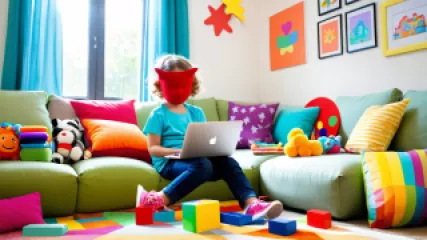What Is the Best Online Counseling for Kids with Behavioral Issues?
Understanding Behavioral Issues in Children
Behavioral issues in children can be a challenging aspect of parenting and often require specialized strategies and interventions to manage. These issues can manifest in various forms, including aggression, defiance, hyperactivity, and withdrawal. Understanding the underlying causes and recognizing the signs early on are critical steps in addressing these concerns effectively.
Common Causes of Behavioral Issues
Several factors can contribute to behavioral issues in children. These include:
- Environmental Factors: Stressful home environments, inconsistent discipline, and exposure to violence can significantly impact a child's behavior.
- Biological Factors: Genetic predispositions, neurological conditions, and developmental disorders like ADHD and autism spectrum disorders.
- Psychological Factors: Trauma, anxiety, depression, and other mental health conditions can lead to behavioral challenges.
- Social Factors: Peer pressure, bullying, and social isolation can also play a role in shaping a child's behavior.
Signs of Behavioral Issues
Recognizing the signs of behavioral problems is essential for timely intervention. Some common indicators include:
- Frequent temper tantrums or emotional outbursts
- Persistent defiance or refusal to follow rules
- Excessive arguing with adults or authority figures
- Aggressive behavior towards peers or siblings
- Difficulty maintaining attention or focus
- Withdrawal from social interactions or activities
The Role of Online Counseling for Kids
With advancements in technology, online counseling has emerged as a valuable resource for addressing behavioral issues in children. This form of therapy provides a convenient and accessible way for children and parents to receive professional help without the constraints of location or scheduling conflicts.
Benefits of Online Counseling
Online counseling offers several advantages that can be particularly beneficial for children with behavioral issues:
- Accessibility: Children can receive therapy from the comfort of their homes, making it easier to fit sessions into busy schedules.
- Flexibility: Online platforms often offer flexible appointment times, accommodating different time zones and availability.
- Comfort: Being in a familiar environment can help children feel more at ease during sessions, promoting openness and engagement.
- Confidentiality: Online counseling maintains privacy and confidentiality, which can be reassuring for both children and parents.
Types of Online Counseling for Children
Various forms of online counseling can address different aspects of behavioral issues in children:
- Individual Therapy: One-on-one sessions with a licensed therapist to explore and address specific behavioral concerns.
- Group Therapy: Sessions with multiple participants, providing a supportive environment to share experiences and strategies.
- Family Therapy: Involves family members to address dynamics and improve communication and relationships within the household.
- Cognitive Behavioral Therapy (CBT): A structured approach that focuses on identifying and changing negative thought patterns and behaviors.
- Play Therapy: Uses play-based activities to help children express emotions and develop coping skills.
How to Choose the Best Online Counseling Service
Selecting the right online counseling service for your child is crucial for effective intervention. Here are some key considerations to keep in mind:
Qualifications of Therapists
Ensure that the therapists are licensed and have experience working with children. Look for credentials such as:
- Licensed Clinical Social Worker (LCSW)
- Licensed Professional Counselor (LPC)
- Child Psychologist
- Marriage and Family Therapist (MFT)
Specialization in Child Behavioral Issues
It's essential to choose a service that specializes in addressing child behavioral issues. Therapists should have expertise in dealing with conditions like:
- ADHD
- Oppositional Defiant Disorder (ODD)
- Autism Spectrum Disorders
- Anxiety and Depression
Interactive and Engaging Approaches
Children respond better to interactive and engaging therapy methods. Look for services that incorporate:
- Games and activities
- Visual aids and multimedia tools
- Interactive exercises
Success Stories: Real-Life Experiences with Online Counseling
To provide a well-rounded perspective, let's explore some real-life experiences of families who have benefited from online counseling for their children's behavioral issues.
Case Study: Shayne Ramirez
Shayne Ramirez, a single mother of two boys, shares her journey:
"My youngest son, Ethan, was diagnosed with ADHD when he was seven. Traditional therapy sessions were difficult to manage due to our hectic schedule. Online counseling was a game-changer for us. The therapist used interactive games and visual aids that kept Ethan engaged and made therapy fun for him. Over time, we noticed significant improvements in his behavior and focus. The convenience and effectiveness of online sessions were beyond our expectations." Shayne Ramirez
Case Study: Riley Thompson
Riley Thompson, a father of a teenage daughter, recounts his experience:
"Our daughter, Mia, struggled with anxiety and social withdrawal. We decided to try online counseling, and it turned out to be the best decision. The therapist created a safe and comfortable environment for Mia to open up. She participated in group therapy sessions, which helped her realize she wasn't alone in her struggles. The flexibility of online counseling allowed us to schedule sessions at convenient times, making it easier for Mia to stay committed. Her confidence and social skills have improved significantly." Riley Thompson
Expert Opinions on Online Counseling for Kids
We reached out to several experts in child psychology and online counseling to gather their insights on the effectiveness of this approach.
Dr. Lillian Palmer, Child Psychologist
Dr. Lillian Palmer, a renowned child psychologist, explains:
"Online counseling has proven to be an invaluable resource for children with behavioral issues. The flexibility and accessibility it offers can break down barriers to receiving help. Moreover, many children find the digital format less intimidating, allowing them to engage more openly. It's important, however, to ensure that the therapists are well-trained and experienced in using online platforms to maximize the benefits." Dr. Lillian Palmer
Juliette Brown, Licensed Professional Counselor
Juliette Brown, a licensed professional counselor, adds:
"In my practice, I've seen remarkable progress in children who participate in online counseling. The integration of multimedia tools and interactive exercises can make therapy sessions more engaging and effective. Parents also benefit from the convenience, as they can be more involved in the process without the logistical challenges of in-person sessions. The key is to choose the right platform and therapist who can tailor the approach to the child's unique needs." Juliette Brown
Parental Involvement in Online Counseling
Parental involvement is a crucial factor in the success of online counseling for children. Here are some ways parents can support their child's therapeutic journey:
Creating a Supportive Environment
Ensure that the home environment is conducive to therapy sessions by:
- Setting up a quiet and comfortable space for sessions
- Minimizing distractions and interruptions
- Encouraging open communication and expression of feelings
Monitoring Progress
Regularly check in with the therapist to monitor your child's progress. Discuss any concerns or observations you may have and collaborate on strategies to reinforce positive behaviors at home.
Implementing Therapeutic Strategies
Work with the therapist to implement therapeutic strategies and techniques in daily routines. Consistency and reinforcement are key to achieving long-term improvements in behavior.
Challenges and Solutions in Online Counseling
While online counseling offers numerous benefits, it also comes with its own set of challenges. Here are some common challenges and potential solutions:
Technical Difficulties
Technical issues such as poor internet connection or software glitches can disrupt sessions. To mitigate these issues:
- Ensure a stable and high-speed internet connection
- Familiarize yourself with the online platform before sessions
- Have a backup plan in case of technical failures (e.g., phone sessions)
Maintaining Engagement
Keeping children engaged in virtual sessions can be challenging. Therapists can use interactive tools and techniques to maintain interest, such as:
- Incorporating games and activities relevant to the therapy goals
- Using visual aids and multimedia presentations
- Setting short, manageable tasks and goals for each session
Ensuring Privacy and Confidentiality
Maintaining the privacy and confidentiality of online sessions is paramount. Choose platforms that offer secure, encrypted communication channels and educate your child about the importance of privacy during sessions.
The Future of Online Counseling for Kids
The future of online counseling for children with behavioral issues looks promising, with continuous advancements in technology and therapeutic approaches. Here are some emerging trends and innovations to watch out for:
Artificial Intelligence and Machine Learning
AI and machine learning can enhance online counseling by providing personalized recommendations and adaptive interventions based on individual needs and progress.
Virtual Reality (VR) Therapy
VR therapy offers immersive experiences that can simulate real-life scenarios, helping children develop coping skills and practice positive behaviors in a controlled environment.
Telehealth Integration
The integration of telehealth services with traditional healthcare systems can provide a more holistic approach to addressing behavioral issues, combining medical, psychological, and social support.
Conclusion: Finding the Best Online Counseling for Your Child
In conclusion, online counseling can be a highly effective solution for children with behavioral issues. By carefully selecting the right service, involving parents in the process, and staying informed about emerging trends, families can navigate the challenges and achieve meaningful progress. The key is to remain proactive, supportive, and open to new approaches in the ever-evolving landscape of online mental health care.
Whether it's through youth coaching sessions, implementing parenting tips for challenging behavior, or seeking online counseling for kids, taking the first step towards addressing behavioral issues can make a significant difference in a child's life. Remember, every child is unique, and finding the best approach requires patience, understanding, and collaboration.






